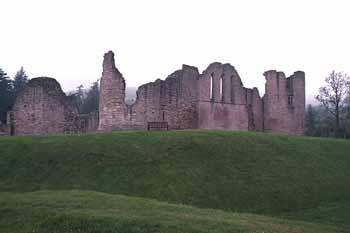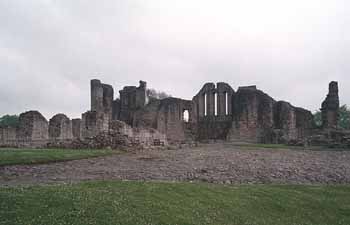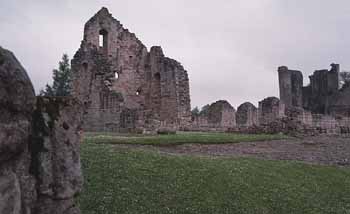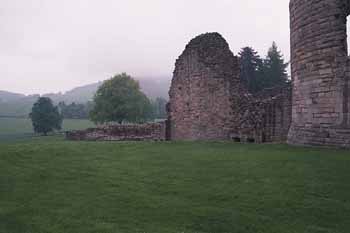
C a s t l e s
Travel Home
Travelogue
Planning
Resources
Itinerary
Scottish Castles
Abbeys and Kirks
Other sights
email Phouka
|
castle |


The facade of Kildrummy castle, looking at the foundations of the twin entrance towers
 Kildrummy Castle is one of the larger castles we saw, and (although it was drizzling -- a fine Scottish day) it was very imposing. The high curtain walls, some of which are still standing, enclosed a courtyard with six round towers at the corners and gate. The largest tower, the Snow Tower, may have been the main keep.
Kildrummy Castle is one of the larger castles we saw, and (although it was drizzling -- a fine Scottish day) it was very imposing. The high curtain walls, some of which are still standing, enclosed a courtyard with six round towers at the corners and gate. The largest tower, the Snow Tower, may have been the main keep.
The gatehouse is quite ruined, but defended by two towers. Nearby is the hall block, the walls of which are the best preserved part of the castle. At one time, it was thought that the d-shaped court was about 55m across. Only the hall and parts of the 2.6m thick curtain wall have been dated to 1228-40 as part of the orginal castle. Since Kildrummy has been sacked, destroyed, and rebuilt many times, it is interesting that parts of the original walls still stand.
The two d-shaped towers that flank the entrance are from 1260-1300. The four towers have plinths, or slighly widened bases. However, the towers forming the outer part of a gatehouse on the south side have battered bases instead of plinths. It is thought that Kildrummy is an imitation of such castles as Harlech, Beamaris, and Aberystwyth in Wales.

The courtyard is enormous, viewing the entrance towers from inside
Both the gatehouse and the other towers had passages leading to latrines in the adjacent sections of a curtain wall.Each tower has a staircase, only the lowerst courses remain fo the Snow Tower, although part stood to it's full height before it collapsed in 1805. It was 16m in diameter.
The warder's tower still partly stands, although the inner parts are gone. the lowest room with a lastrine but no windows ws a prison. Nest to the Warden's tower is a postern from chich a passage led down to a cistern chamber and a means of escape beside the stream.
The original castle dates from the 12th century, and was a small motte created out of the top of a glacial mound. This stone castle, west of the original, was built under the direction of Gilbert de Moravia, Bishop of Caithness, for Alexander II to command the roads between the provinces of Moray and Mar.
Kildrummy remained a powerful fortress when the Earls of Mar had custody of it. Edward I of England was at Kildrummy in 1296 and 1303; in 1305 he ordered Robert Bruce, Earl of Carrick, custodian. In 1306, Edward besieged Kildrummy and the ladies of Bruce's court, during the Lord's absence. The women put up a good defense but were forced to submit after Osborne the blacksmith treacherously set fire to the grain stores and the castle. Stone does burn. The garrison were caught and history records that the women were "mistreated". A polite euphemism, no doubt.

Most of Kildrummy is gone, this is the remains of the hall
At some point, the castle was rendered uninhabitable by the destruction of the west wall, but it is likely this was done by the Bruce's themselves to keep Kildrummy out of English hands.
The castle was restored by 1333, when it formed the prison of Duncan, Earl of Fife. David II visited the castle several times, and (what a lousy guest!) he besieged and captured it in 1361. In 1404, the castle was awarded to Alex Stewart, who took it by marrying Isabela, Countess of Mar. She wasn't a willing bride on this occasion. On Alex's death in 1435, the castle and earldom were retained by James I.
In 1507, Kildrummy was granted to Alexander, 1st lord of Elphinstone, whose family retained it until 1626. They remodelled what is now called the Elphinstone Tower. In 1531, the castle was stormed and plundered by the freebooter John Strachan. In 1690, Graham of Claverhouse burnt the castle rather than allow it to be occupied by the English.
Once again, Kildrummy was rebuilt, and it was occupoed by 1715. It was subsequently dismantled by the government and became a quarry for the district, the fate of many large stone castles. Repairs were executed from 1898 to 1931, and it was then given to the state.

The foundation of the Snow tower
